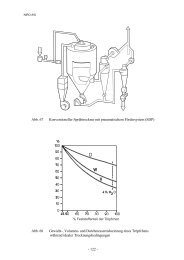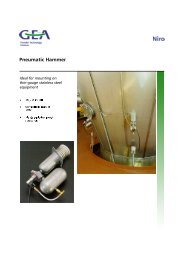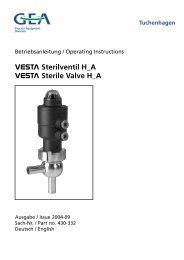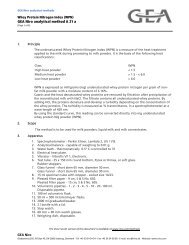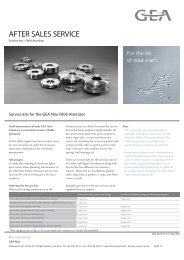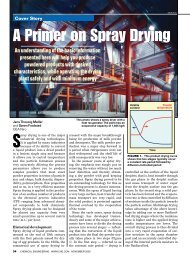41119_Niro jubilaeumsbog_blok_uk - GEA Niro
41119_Niro jubilaeumsbog_blok_uk - GEA Niro
41119_Niro jubilaeumsbog_blok_uk - GEA Niro
Create successful ePaper yourself
Turn your PDF publications into a flip-book with our unique Google optimized e-Paper software.
The challenges of drying milk<br />
Born on a Friday the 13th and fled from the communist regime<br />
with his family on October 13, 1968 at 1300 hours was perhaps<br />
not the most optimistic basis for a great career as head of <strong>Niro</strong>’s<br />
milk development department. But Jan Pisecký from the Czech<br />
Republic had other plans.<br />
With a background as a chemical engineer from the Technical<br />
University of Prague and a Ph.D. degree thereafter, Jan Pisecký<br />
became head of the Czech Dairy Research Institute – a position<br />
which for political reasons was intolerable to him. Until<br />
1968 there had not been many development projects at <strong>Niro</strong><br />
for milk powder spray plants, but after Jan Piceský was<br />
hired, things started to happen.<br />
The first challenge for <strong>Niro</strong> was to make a whole milk powder,<br />
which contains milk fat, soluble in cold water.<br />
Some of the milk fat is forced out onto the surface of the<br />
powder particles, which makes the particles water-repellent<br />
– especially when the water is cold. One of the requirements<br />
was that only “natural ingredients” which the milk already<br />
contained were allowed to be added. This sounded easy, but<br />
it took more than a year for two employees to take the process<br />
from the laboratory to an industrial plant that could produce<br />
a whole milk powder that was cold water-soluble.<br />
The task was solved by spraying a lecithin solution on the<br />
surface of the milk powder particles – a process that customers<br />
lined up to buy.<br />
34 | 35<br />
Need for product quality among customers<br />
Some of the development projects were inspired by the need<br />
to solve customers’ problems with product quality. The<br />
biggest problem was the density of the milk powder. Almost<br />
all of <strong>Niro</strong>’s milk plants were based on atomization of the<br />
fluid milk concentrate into small particles with a rotating<br />
ato mizer; that is, a component that converts the liquid into<br />
particles, which are then dried to powder.<br />
This resulted in a lighter powder than the one our competitors<br />
– especially from the U.S. and Japan – could produce. Not<br />
even <strong>Niro</strong>’s famous, patented “milk wheel” was able to solve<br />
the problem of product quality. During the energy crisis in<br />
the 1970s, when saving energy was a requirement, plants<br />
able to dry the powder in two steps were developed, since it<br />
is cheaper to remove the residual moisture in a vibrating<br />
after-dryer – called a VIBRO-FLUIDIZER ® – compared to a<br />
spray drying plant.<br />
Two-step drying, as it was called, provided better drying<br />
economy but also a heavier powder. With <strong>Niro</strong>’s high-pressure<br />
nozzles the powder became even heavier, and <strong>Niro</strong> was ahead<br />
of the competition again. But the development activities<br />
didn’t stop there. Customers required even better drying<br />
economy and higher quality drying, and showed interest



